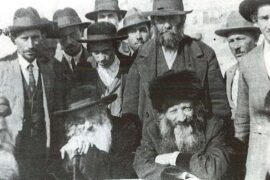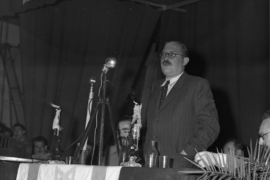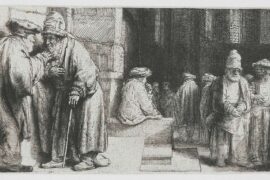After years of crusading against the idolatrous beliefs and practices of the ancient world, Avram had to undergo a series of difficult challenges to help him refine his own trait of ḥesed and internalize the necessary psychological transformation from a nomadic leader of a vibrant spiritual movement to the father of a distinct nation in a specific geographic territory.
For more content from VISION Magazine, subscribe to our newsletter and follow us on Twitter @VISION_Mag_, Facebook and YouTube. If you haven’t already, don’t forget to subscribe to our podcast on SoundCloud, iTunes, Stitcher, TuneIn, or Spotify and leave a rating and review to help us get our message out to a wider audience! To support the podcast, head over to our PayPal portal and be sure to write a note that your contribution is for the podcast. Hosted by: Yehuda HaKohen
Transcript:
In Parshat Lekh Lekha, we begin closely following the adventures of Israel’s first patriarch Avraham.
Avraham was known as a Hebrew, an Ivri, but he’s not the first Hebrew. It’s clear from certain verses in the Torah that there was already a people known as the Ivrim – and they are essentially the descendants of Ever – although Ever’s great grandfather Shem and his father Noaḥ can also be counted among the early Hebrews. For lack of a better term, we can view these Hebrews as proto–Israelites.
There was also a country known as the Land of the Hebrews – Eretz HaIvrim – as we can see from a conversation later had by Yosef in an Egyptian prison. After being conquered by the Canaanites, this country became widely known as the Land of Canaan but many people still referred to it as the Land of the Hebrews.
The ancient Hebrews also possessed a unique spiritual worldview, which we can call ethical panentheism. The ancient Hebrews believed that everything that exists – the sun, the moon, all of nature, people, events, ideas, time – exists within a timeless ultimate Reality without end that Creates all, sustains all and loves all. And that this ultimate Reality – this Creator – also Authors history and continues to be directly involved in the Creation.
These proto–Israelite Hebrews enjoyed a personal relationship with the Creator and they wanted the rest of humanity to share that relationship.
But human civilization was so corrupt and so steeped in idolatry that Hebrew teachings couldn’t effectively penetrate. Once humanity began the process of fragmenting into national identities, the ability of these spiritual giants to influence the world was decreased. Holy individuals were no longer enough to bring the world to a universal awareness of its Creator and inner Source. That goal would now require the creation of a holy nation.
Ever’s son Peleg had a son named Reu who had a son named Serug who had a son named Naḥor who had a son named Teraḥ. These names are important because they chart the development of the Hebrew identity and mission.
Ever named his son Peleg because he saw prophetically that humanity would be dispersed during his lifetime at the Tower of Babel. This obviously bothered him as it diminished his family’s ability to succeed in their mission. Peleg named his son Reu, meaning friendship, in hopes of reuniting mankind. Reu named his son Serug in hopes of knitting humanity back together.
But after this, the family appears to have given up. Noaḥ, Shem and Ever continued to serve as righteous individuals but their impact on humanity tended to be weak. And when the Canaanites invaded and began to conquer the Land of the Hebrews, Teraḥ fled with his family to Ur Kasdim.
Teraḥ’s son Haran was born in Ur Kasdim. But Teraḥ already had two other sons – Avram and Naḥor – who had been born elsewhere to another wife.
And it’s Avram who not only becomes a passionate adherent of the Hebrew worldview, but also the first Hebrew to take a militant anti–idolatry position. This is interesting because our Sages teach us that Teraḥ was a major spiritual figure in Ur Kasdim, who created and sold idols – idols that his son Avram would eventually smash. And throughout history, we see Jews creating ideologies for the world and then often destroying them. Jews aren’t the only people to produce ideologies and not every ideology has been created by Jews. But there’s no other people in history who can be credited with creating or destroying more idols than Israel.
So Avram was a man of extreme ḥesed. This quality expressed itself through both a love of the Creator and a love for human beings that he sought to bring close to the Creator. This attribute of ḥesed made Avram uniquely qualified to be the progenitor of the Israeli nation but it was also a trait that would need to be refined through a series of challenges that would force Avram to act against his own natural tendency of ḥesed and to develop into the person he must become to fulfill his mission.
In any case, Avram’s militant crusade against idolatry ultimately brought him into conflict with Nimrod, the king of Babylon. He was thrown into a furnace but miraculously survived. His brother Haran, however, was killed in the furnace. After this, Teraḥ and his surviving sons, together with Haran’s orphaned children, began to make their way back to the Land of the Hebrews.
The family only got as far as Aram – or more specifically Ḥaran – a major cosmopolitan center at the time. Naḥor took Haran’s daughter Milka as a wife. And Avram married her sister Sarai – who’s quality of g’vura would later help him to refine his own trait of ḥesed. Avram also took on his nephew/brother–in–law Lot as his apprentice. And together, Avram, Sarai, Lot and most likely also Naḥor and Milka began to attract many disciples in Aram.
It’s important to note that the primary difference between Avram’s teachings and the dominant ideologies of the time wasn’t merely the difference between a belief in one G–D versus several gods.
The panentheist Hebrew worldview not only asserts that there is only one G–D who Creates all but also that everything that exists is a part of that Creator. Everyone and everything that exists is part of – and a unique expression of – that ultimate Reality we call HaShem – that always was, is and will be.
But that’s not all that separates the Hebrew worldview from the prevalent ideologies of the ancient world. Another major difference is that these other views related to whatever supreme powers they believed in as impersonal and domineering. People saw their gods as not caring about human beings and therefore impossible to have a personal relationship with.
The Hebrew view, by contrast, relates to the Supreme Power as a personal G–D who isn’t indifferent to His creations but loves each one, cares about us, wants good for us, and therefore seeks to bring us close to Him so we can best fully actualize ourselves and live full meaningful lives.
From the Hebrew perspective Avram was teaching, all of the difficulties in a person’s life are the challenges that HaShem gives us so that, by solving and overcoming them, we can advance both ourselves and the rest of the world.
This approach leads a person to recognize HaShem as having created man in His own image, endowing us with thoughts, feelings, and freedom of choice for the sake of being able to engage with us in dialogue. All of our thoughts and actions are our words in dialogue with the Creator, while everything that happens to us and around us are HaShem’s words to us.
This personal relationship allows us to experience our lives, the world and all of human history as a dialogue between us and the Creator. In this dialogue, which compels us to conduct ourselves not only morally and ethically but also responsibly, we attain for ourselves and reveal for others diverse manifestations of HaShem’s Divine light.
So by the time Avram was 75 years old, he and his wife Sarai were still childless but they had already spread their novel perspective to flocks of students who began to comprise their community. As a spiritual leader, Avram was successful and it’s understandable that he saw his ministry as the vehicle through which he’d work to reorient humanity towards understanding its true relationship with the Creator.
But then HaShem spoke to Avram directly and instructed him to continue on from Aram to the Land of the Hebrews in order to establish a unique nation that will bring humankind to higher awareness and fulfillment. We see this Divine instruction in B’reishit 12, verses 1-3:
“HaShem said to Avram, ‘Go for yourself from your land, from your relatives, and from your father’s house to the land that I will show you. And I will make of you a great nation; and I will bless those who bless you, and him who curses you I will curse; and all the families of the earth shall bless themselves by you.”
At the end of Parshat Noaḥ, we see Noaḥ’s descendants evolve from families with unique cultural identities and territories to become nations. And here Avram was being told that he must travel to a specific land in order to become a great nation that will bring blessing, not to the nations but to the families of the earth.
So what’s the real difference between a nation and a family?
How they act towards one another.
The relationship between nations is by definition exclusivist and distrustful. Each nation seeks to strengthen itself and its interests, even if that harms the interests or wellbeing of another nation. But the relationship between families can be inclusive. And those relationship dynamics can lead to a universalism that respects differences in identity and doesn’t demand uniformity.
But what was important for Avram to internalize is that the Hebrew mission, which seeks to reunite mankind by transforming nations back into families, requires the creation of a unique holy nation.
It happens to be a very strong Hebrew trait to strive for universality, for a connection with all humankind for the sake of humankind’s benefit. The danger of this trait is that universalism can very easily be confused with cosmopolitanism – the idea that for the sake of being truly universal, one must deny his own particularist identity and national interests.
HaShem’s prophecy to Avram sent the exact opposite message. Achieving universal goals must come through a nationalist vehicle. This prophetic experience was a major turning point in Avram’s life and worldview.
But before getting into Avram’s reaction to this directive and the internal struggle that will dominate the rest of his career, it’s important to recognize the extent to which the events of Teraḥ’s family, who essentially comprised the Hebrews of that generation, have been mirrored by the Jewish people in modern times.
Our Sages teach us that “ma’ase avot siman l’banim” – “the deeds of the fathers are a sign for the children.”
Teraḥ had three sons, Avram, Naḥor and Haran. Each should be considered a third of the Hebrew identity that will later come to be known as Israel. Haran, one third of Israel, is killed in an oven in Ur Kasdim.
Naḥor, the second third, embraces cosmopolitanism and remains in Aram, where he attempts to influence his surroundings in a manner very similar to Rav Shimshon Raphael Hirsch in 19th century Germany – as a religion existing in a major cosmopolitan center so as to be able to influence human civilization. But after a couple generations, we see that Naḥor’s children and grandchildren are no longer Ivrim – no longer Hebrews – but suddenly Aramim – Arameans. Meaning that after one third of Israel was killed in an oven, a second third of Israel came to one of the world’s major cultural centers and ultimately lost its identity by assimilating into the local identity.
Avram, the third third of Israel at the time, was also in the process of creating a universal religion in Aram when he was Divinely instructed to return to the Land of the Hebrews, from where his ancestors had been displaced, and to build a nation that will be able to influence humanity without losing its unique Hebrew character and identity.
The Rambam considers leaving Aram to be the first challenge Avram had to overcome on his journey. Our Sages explain the name Avram as “Av Aram” – “the father of the Arameans.” He was the major spiritual figure and religious leader of Aram.
Avram’s militant crusade against idolatry brought him into conflict with Nimrod’s regime but it had also inspired much of the Mesopotamian population. It drew many students to his revolutionary teachings and created a vibrant spiritual movement. Avram’s departure from Aram should therefore be seen as him overcoming a major internal challenge and resolving a question that would recur several times throughout Israel’s future history. Should a Jew devote himself to raising the moral and spiritual level of gentile nations by living among them? Or would it be better to focus on exclusively Jewish issues while living in the Jewish homeland?
Naḥor opted for the first approach, preaching in a major cosmopolitan center and trying to influence the nations from within. And it seems that Avram likely shared this approach until he received actual nevua. Following that prophetic experience, he of course became eager to follow HaShem’s directives. But this doesn’t mean he was ready to give up his previous work or the movement he built. In fact, the entire narrative of Parshat Lekh Lekha is the story of Avram refining his trait of ḥesed and slowly abandoning his own approach for influencing humanity so he can fully embrace the new mission bestowed on him. But this transition was a process that required a lot of internal work.
Avram brought with him to the Land of Canaan not only his wife, but also his nephew and all their followers. HaShem instructed Avram to make the journey. He didn’t tell him to bring his entire community with him. But despite learning that the Hebrew mission must now be accomplished through a nation that would descend from them, Avram and Sarai were still childless yet they had many many passionate disciples eager to help them advance their mission.
So it makes sense that Avram, with no actual children to raise but surrounded by devoted students, still saw his previous work as having an important role to play in fulfilling the mission HaShem tasked him with. Although at first he was likely following the Creator’s instructions out of deep love and loyalty, in time Avram came to internalize the fact that humanity can’t be influenced through the spread of a religion. Because the world had already been divided up into national identities, it became necessary to create a unique nation that would manifest the Divine Ideal in every sphere of life – from sanitation and warfare to organizing an economy. Only a nation can influence other nations and show that righteousness isn’t limited to the level of individuals.
The process of Avram fully reorienting himself from the goal of creating a religion to the mission of building a nation is a process full of successes and failures but these are all important points on the map of our patriarch’s growth.
The story that unfolds in Parshat Lekh Lekha, and some of the following parshiot, is largely the story of Avram becoming Avraham. It’s the story of the first progenitor of the nation of Israel restricting his own ḥesed to give it proper expression and ultimately giving up on his dreams of creating a universal religion in favor of fully embracing HaShem’s program for achieving Tikun Olam through a Hebrew nation.






Great podcast!
One question really jumped out at me from listening here. From where do you know that Abraham’s ancestors were displaced from the Land of Israel? It sounds like you implied that the Land of the Ivrim was Israel. If that’s correct, what is the source?